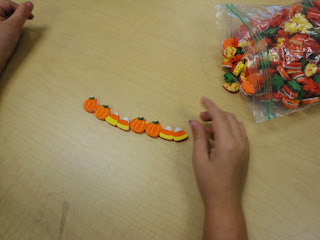We are working really hard on number concepts and patterning at this point of our school year. Young learners remember concepts best when they are able to use hands-on items to make concrete connections when working with numbers. This time of year places like Target, the dollar stores and other stores have many cheap materials you can use to make learning math fun! The best time to get those items is when they are on clearance. We wanted to share some pictures with you to give you an idea on how to support what they are learning at school at home. We will really be working on patterns and how to read the patterns at school. We encourage you to play some of the games in the pictures at home to help your child master the skill of patterning.
This child is practicing rolling the dice and finding the corresponding correct number of items for each die. To challenge them you can ask them to add all of the items together to find the total (we use those word to start teaching them proper math vocabulary). You can also ask them how many items they have "all together".
This was a super easy game to make. We cut out different shaped pumpkins from orange construction paper, put numbers on them from the number 0 through 20 and we use them to put number in order (cardinality), find which number is biggest (by placing two pumpkins on the ground and asking them to find the number that is largest (bigger, greater, most) or the smallest (least or less). We added some dollar store plastic spiders so the students could practice matching the number symbol (6) or number word (six) with the correct number of spiders. They love this game.
Another way to reinforce patterning at home? Break out the Lego/Building Blocks and use them to create patterns. This is an easy way to take items you may already have at home and use them to reinforce math concepts. You could also ask your child to build something with only fifty blocks, twenty blocks, one hundred blocks and have them count them out. The possibilities to teach with these small building blocks are endless.
The most fun item we are using right now are cheap plastic cups in fall colors. We use them to create patterns, buildings and just to have fun creating things. These students have mastered patterning with the cups. They absolutely love this activity in Ms. Arrendale's class. This is just another way you can have fun with your child at home and reinforce patterning while spending a quality time with your young mathematician.
We found these cute monsters on a learning web site and printed them out and laminated them. We bought some cheap googly eyes at Walmart and added some dice and we created this fun math game. You can roll one die and add that many eyes to the monster or you can roll two dice and add the numbers together, find the total and place that many eyes on the monster.
The last thing you can use to create patterns is cereal. We had a parent donate some apple cereal and the students loved creating patterns and then eating them! This child created an AAB, AAB pattern (they read the pattern as green, green, orange and labeled it as an AAB pattern).
We hope these little tips give you a few new ideas on how you can continue learning at home in a fun and interactive way. We appreciate all you do to help your young mathematician develop strong foundational skills in number concepts and patterning. Feel free to take pictures of your mathematician practicing at home and send them to us. They can strengthen their speaking and listening skills by sharing what they did and explaining why they did it that way. Asking your child to justify, or explain, why they decided to create a pattern a certain way helps them to think about math and learn how to reason. This is another critical skills that will help them excel in all academic areas.








